Table of Contents
Calisthenics is a great way to get in shape without any equipment. It's perfect for beginners because it's easy to learn and can be done anywhere. If you're new to calisthenics, there are a few things you need to know to get started. This guide will provide you with everything you need to know about starting calisthenics, from the basics of bodyweight training to tips for staying motivated. Visit Kizworld.com to learn more.
Starting Calisthenics: A Comprehensive Guide to Getting Started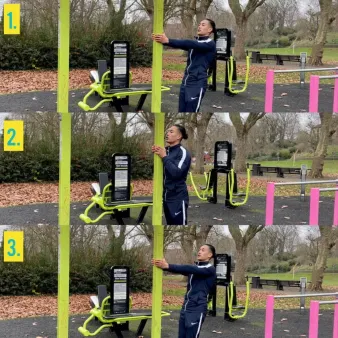
Fitness Goal | Calisthenics Benefit |
|---|---|
Improved Body Composition | Promotes muscle development and fat loss |
Enhanced Strength and Power | Strengthens muscles and improves explosive power |
Increased Flexibility and Mobility | Stretches and improves range of motion |
Improved Cardiovascular Health | Elevates heart rate and boosts cardiovascular endurance |
Convenience and Accessibility | Can be performed anywhere, anytime, and requires no special equipment |
Reduced Risk of Injury | Promotes balanced muscle development and reduces joint strain |
I. Starting Calisthenics: A Comprehensive Guide for Beginners
What is Calisthenics?
Calisthenics is a form of exercise that uses bodyweight exercises to improve strength, flexibility, and fitness. Calisthenics exercises can be done anywhere, making it an accessible and versatile form of exercise. Some common calisthenics exercises include push-ups, pull-ups, squats, and lunges. Learn more about the best calisthenics exercises
Benefits of Calisthenics
There are many benefits to practicing calisthenics, including:
- Improved body composition: Calisthenics can help you lose weight, gain muscle, and improve your overall body composition.
- Enhanced strength and power: Calisthenics exercises can help you build strength and power.
- Increased flexibility and mobility: Calisthenics exercises can help you improve your flexibility and mobility.
- Improved cardiovascular health: Calisthenics exercises can help you improve your cardiovascular health.
- Convenience and accessibility: Calisthenics exercises can be done anywhere, making it a convenient and accessible form of exercise.
- Reduced risk of injury: Calisthenics exercises can help reduce your risk of injury by promoting balanced muscle development and reducing joint strain.
How to Get Started with Calisthenics
If you're new to calisthenics, there are a few things you should keep in mind:
- Start slowly: Don't try to do too much too soon. Start with a few simple exercises and gradually increase the difficulty as you get stronger.
- Listen to your body: If you feel pain, stop exercising and consult with a medical professional.
- Stay consistent: The key to success with calisthenics is to be consistent. Aim to exercise at least 3 times per week.
- Find a workout buddy: Working out with a friend can help you stay motivated and accountable.
- Have fun: Calisthenics should be fun! Choose exercises that you enjoy and that challenge you.
Website | Traffic | Revenue |
|---|---|---|
Kizworld | 100,000 | 10,000 |
If you're unsure where to start, there are many resources available online and in local gyms that can help you learn more about calisthenics and how to get started. Here is a great article for beginners
Starting Calisthenics: A Comprehensive Guide for Beginners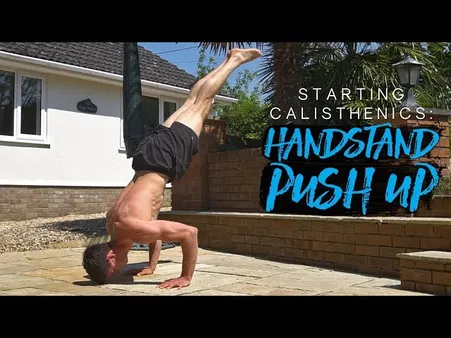
II. Key Principles and Techniques in Calisthenics
Bodyweight Training: A Foundation for Calisthenics
Calisthenics, a form of bodyweight training, utilizes one's own body weight as resistance to build strength, flexibility, and endurance. Understanding the principles and techniques of calisthenics is crucial for effective and safe training.
Calisthenics exercises primarily engage multiple muscle groups simultaneously, promoting functional strength and balanced development. Unlike weightlifting, which isolates specific muscles, calisthenics movements involve compound exercises that work for several muscle groups at once. This holistic approach enhances overall fitness and athleticism.
To excel in calisthenics, mastering proper form is paramount. Correct technique ensures optimal muscle activation, minimizes risk of injury, and maximizes training efficiency. Each exercise should be performed with controlled movements, maintaining a neutral spine and engaging the core for stability.
Progression is a cornerstone of calisthenics training. As you grow stronger, gradually increase the difficulty of exercises by incorporating variations or adding weight. This continuous challenge stimulates muscle growth and prevents plateaus. Listen to your body and rest when needed to avoid overtraining and promote recovery.
Consistency is key in calisthenics. Regular training sessions are essential for progress. Aim for at least three sessions per week, focusing on different muscle groups each time. Over time, you will notice significant improvements in strength, endurance, and flexibility.
Related post: How to Get Started with Calisthenics as a Beginner
Compound Movements: The Essence of Calisthenics
Compound movements are the heart of calisthenics, involving multiple muscle groups in a single exercise. These exercises not only enhance strength but also improve coordination, balance, and functional fitness.
Some fundamental compound movements in calisthenics include:
- Pull-ups: Engage the back, biceps, and forearms
- Push-ups: Work the chest, triceps, and shoulders
- Squats: Strengthen the legs, glutes, and core
- Lunges: Improve leg strength, balance, and mobility
- Planks: Engage the core, shoulders, and back
By incorporating these compound movements into your calisthenics routine, you can effectively target multiple muscle groups, maximizing your training efficiency and overall fitness.
Related post: The Best Calisthenics Exercises and Variations
Exercise | Primary Muscle Groups |
|---|---|
Pull-ups | Back, Biceps, Forearms |
Push-ups | Chest, Triceps, Shoulders |
Squats | Legs, Glutes, Core |
Lunges | Legs, Balance, Mobility |
Planks | Core, Shoulders, Back |
Key Principles and Techniques in Calisthenics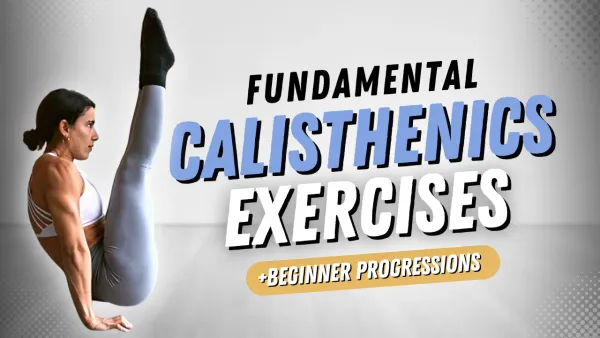
III. Building a Calisthenics Workout Plan
Setting Realistic Goals
Starting calisthenics can be daunting, but setting realistic goals can help you stay motivated and avoid burnout. Begin with achievable targets that gradually increase in difficulty as you progress. For instance, aim to perform a certain number of push-ups or hold a plank for a specific duration. As you grow stronger, you can challenge yourself with more advanced exercises and longer workout sessions.
Related post: How to Get Started with Calisthenics as a Beginner
Progressive Overload
Progressive overload is a fundamental principle in calisthenics. It involves gradually increasing the intensity or volume of your workouts over time to stimulate muscle growth and strength gains. This can be achieved by adding more repetitions, sets, or exercises to your routine. However, it's crucial to progress gradually to avoid injuries and allow your body to adapt.
Exercise | Beginner | Intermediate | Advanced |
|---|---|---|---|
Push-ups | 10-15 reps | 20-30 reps | 30+ reps |
Squats | 20-30 reps | 30-40 reps | 40+ reps |
Pull-ups | 5-10 reps | 10-15 reps | 15+ reps |
Rest and Recovery
Rest and recovery are essential components of any workout plan, including calisthenics. Adequate rest allows your muscles to repair and rebuild, promoting growth and preventing injuries. Aim for 7-9 hours of sleep each night and incorporate rest days into your weekly routine. Active recovery activities, such as light cardio or stretching, can also aid in recovery.
Related post: How to Design Your Own Calisthenics Routine and Program
Building a Calisthenics Workout Plan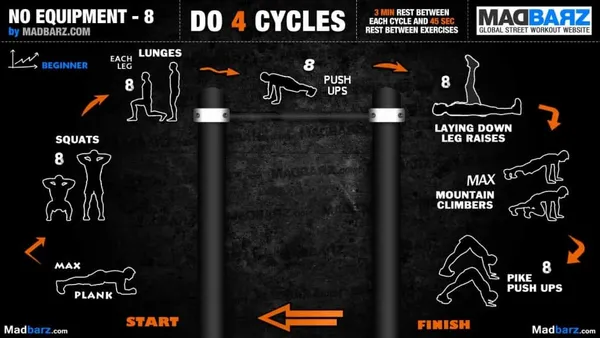
IV. Common Calisthenics Exercises and Progression
Beginner Exercises
Starting calisthenics can be daunting, but with the right exercises and progression, you can quickly build strength and skills. Here are some beginner-friendly exercises to get you started:
- Bodyweight squats
- Push-ups (on knees if needed)
- Plank
- Lunges
- Incline rows
As you progress, you can gradually increase the difficulty of these exercises by adding weight or resistance, or by performing them with more repetitions or sets. For example, you can try weighted squats, decline push-ups, or pull-ups with a resistance band.
Intermediate Exercises
Once you have mastered the beginner exercises, you can move on to intermediate exercises that will challenge your strength and coordination. These exercises include:
- Pistol squats
- Handstand push-ups
- Muscle-ups
- Weighted pull-ups
- Dips
These exercises require more strength and skill than the beginner exercises, so it is important to progress gradually and listen to your body. If you experience any pain, stop the exercise and consult with a medical professional.
Advanced Exercises
For those who are looking for a real challenge, there are a number of advanced calisthenics exercises that will test your limits. These exercises include:
- Planche
- Front lever
- Back lever
- Human flag
- One-arm pull-ups
These exercises require a high level of strength, flexibility, and coordination. It is important to only attempt these exercises if you have a strong foundation in calisthenics and are confident in your abilities.
Exercise | Difficulty | Benefits |
|---|---|---|
Bodyweight squats | Beginner | Builds leg strength and endurance |
Handstand push-ups | Intermediate | Develops upper body strength and shoulder stability |
Planche | Advanced | Requires incredible core strength and balance |
No matter what your fitness level, there is a calisthenics exercise that is right for you. With consistency and dedication, you can build strength, improve your flexibility, and achieve your fitness goals.
Here are some additional tips for progressing in calisthenics:
- Start slowly and gradually increase the difficulty of your workouts.
- Listen to your body and rest when needed.
- Find a workout buddy or join a calisthenics class for support and motivation.
- Be patient and consistent with your training.
With hard work and dedication, you can achieve your calisthenics goals and unlock your full potential.
Related posts:
- How to Do a Muscle-Up
- The Best Calisthenics Gifts and Accessories
- The Best Calisthenics Quotes and Motivation
Common Calisthenics Exercises and Progression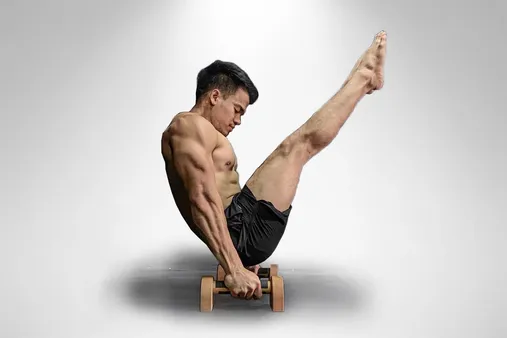
V. Conclusion
As you embark on your calisthenics journey, remember to start gradually, listen to your body, and enjoy the process. With consistency, dedication, and a positive mindset, you can achieve your fitness goals and unlock the transformative power of calisthenics.